JFS – A Four Sites Saga
By David Harris,
longstanding volunteer,
who was previously a teacher and deputy head at JFS for 29 years.
JFS started as Jews’ Free School in the 1730’s in Dukes Place in The City, then moved to the East End and then Camden and is now in Kenton on a large campus.
In the history gallery is a copy of the 1892 work “Children of the Ghetto” written by Israel Zangwill (below)
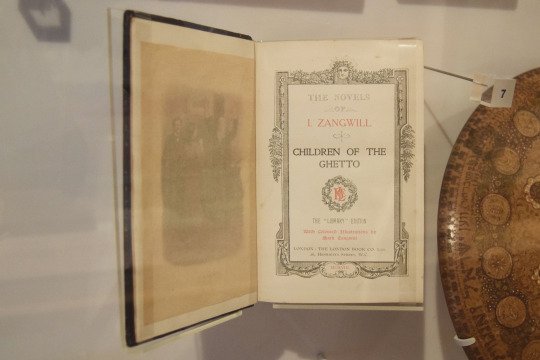
Israel Zangwill, born in 1864, was a pupil, pupil-teacher and teacher at the Jews’ Free School before finding fame and fortune as one of the period’s most famous men of letters. Often referred to as the Jewish Dickens, he had the ear of the great and the good and could count HG Wells, George Bernard Shaw, Sir Arthur Conan Doyle and Rudyard Kipling, as his friends. A critic of the time, Hall Caine, wrote to Zangwill on this novel’s publication telling him that:
“It is wonderful in its reality and force. By this book you have justified your claim to be classed with the foremost writers of your generation.”
Zangwill, an early Zionist, was a key member of the Territorialists, the group whose aim was to establish a Jewish homeland anywhere in the world- not necessarily Palestine- to rescue Jews urgently from oppression.
Opposite the copy of “Children of the Ghetto”, is the Jews’ Commemorative Scholarship Medal (below) – that was awarded annually to the outstanding student of the year at JFS, together with a cheque for £25.
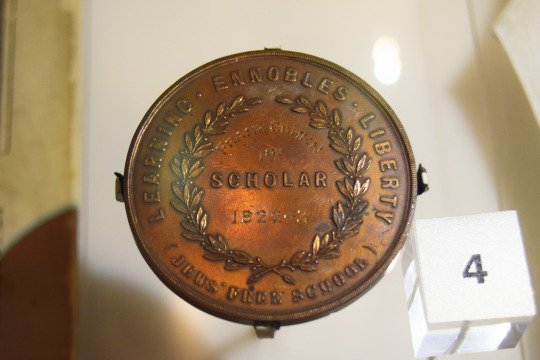
It was first awarded in 1858 to celebrate the fact that Lionel de Rothschild had become the first practising Jew to take his seat in the House of Commons. You can’t tell the history of JFS without mentioning the Rothschilds for whom JFS was a favourite charity. The family’s support of and involvement in the school was- and remains to this day-more than considerable and in “Children of the Ghetto”, Zangwill tells us that “Rothschild was a magic name in the ghetto” and “It stood next to the Almighty’s “as….. a friend of the poor”. Zangwill won this medal – and the £25 that went along with it- twice.
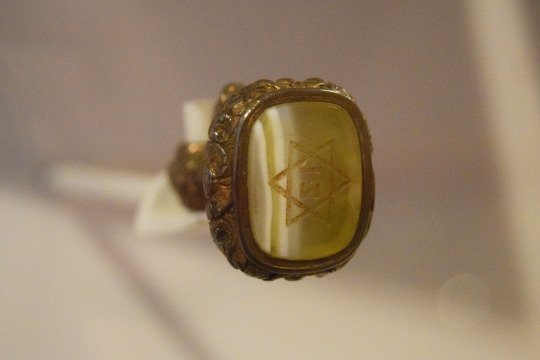
Items 8 and 9 in the gallery- show Zangwill’s seal (above) and a commemorative plate (below) quoting the response Zangwill threw at a heckler who called him an “alien Jew” at a public meeting.
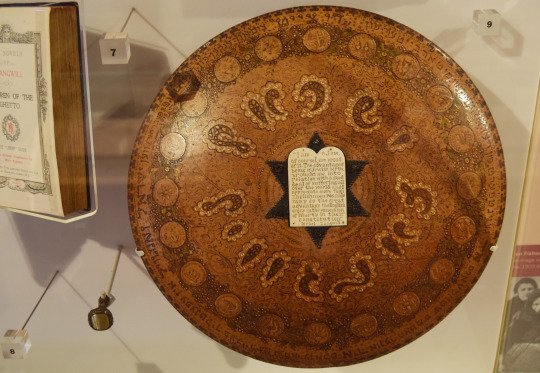
Alas, Zangwill is rarely read these days. But, he does live on in his alma mater because if you have a yellow stripe in your tie then you’re in Zangwill House.
There are two photographs, taken in the early 20th century, of students at the JFS Bell Lane Site (Site Number 2). Underneath one of the pictures is a quotation from “Children of the Ghetto” where Zangwill describes:
“…the bell of the great Ghetto school, summoning its pupils……to come and be Anglicized”

The “great Ghetto school” was, of course, his school, the Jews’ Free and that word “Anglicized” would play a major role in the school’s purpose. For the challenge facing the school-90% of whose role was composed of immigrant families- in those days, was how to make Englishmen out of Jews. The challenge in 2018, some would say, is how to make Jews out of Englishmen!
All of the boys in the photographs are dressed in school uniform and the likelihood is that these clothes were bought for them by the school-(how else could these immigrant families possibly afford the luxury of a school uniform)?- using funds and trusts set up by the Rothschilds and their friends. That’s how in 1908 a pupil was able to declare proudly, that“Every boy in my class has a clean collar”. Even today children’s school activities are subsidised where necessary.
There is a school magazine from May 1912 (below).

Always ahead of its times, I wonder how many other schools of the day could have boasted a school magazine? Lawrence (nee Lazar) Bowman was the head at the time. Bowman had been born in Poland, was a brilliant scholar and led the school for 23 years. Sadly, his son, Claude, also a JFS alumnus was killed in action in Flanders in August 1917. Next to the magazine is a piece of student needlework from a similar period (below).
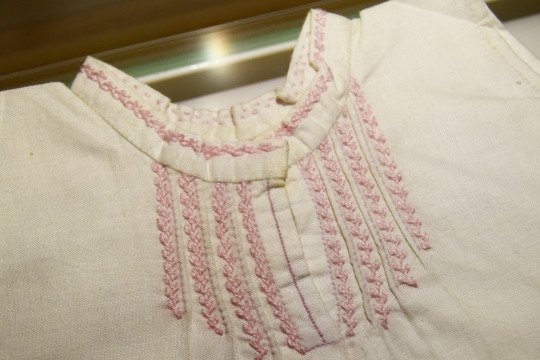
Moses Angel , a towering and legendary head teacher who led the School for over fifty years in the nineteenth century-and still found time to edit the “Jewish Chronicle” for a few years- was of the view that: “Every young woman is the better for knowing how to mend…”
There’s much more to JFS than the outline presented by these items. The miracle was that this school, situated in one of London’s poorest, least favoured and most chaotic areas, was able to take thousands and thousands of immigrant children who came from overcrowded homes where English wasn’t spoken, from parents who were poor and often unemployed, and give them the wherewithal to carve out for themselves a life and a future as proud Jews, citizens of the UK. And now, nearly 300 years later, the fruits of that miracle can be seen in the wonderfully resourced 2000 strong school that continues to produce excellent results and rounded, proud Jewish graduates.
The Reverend Simeon Singer was the editor of the Singer’s Prayer Book, which, published in 1890, was to become the authorised daily prayer book of orthodox synagogues in the UK and the Commonwealth. After a visit to the school in the late nineteenth century, Singer wrote
“It is little short of a marvel that, from material apparently so unpromising, educational results so extraordinary are produced.”
Some would say that it’s not all that different today!
(Photographs and Edit by David Fenton)